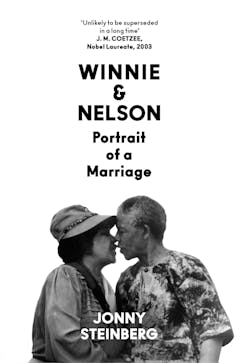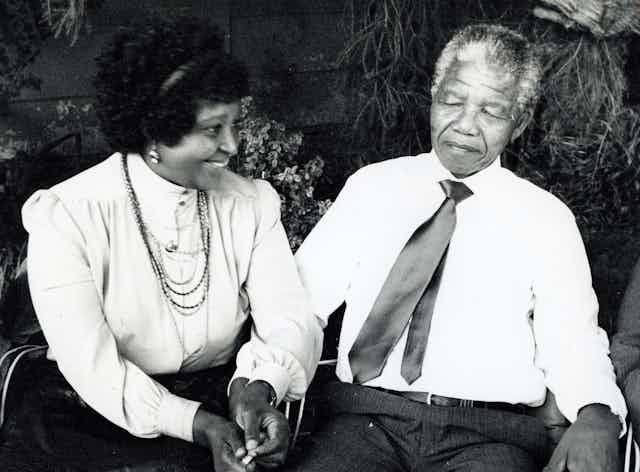A powerful new book on Nelson Mandela and Winnie Madikizela-Mandela has just been published. Winnie and Nelson: Portrait of a Marriage is at once a double biography of South Africa’s two famous liberation leaders and a historical love story about their personal lives. Mandela was imprisoned for 27 years during apartheid and went on to become the country’s first democratic president. For her part Madikizela-Mandela was persecuted relentlessly by the white minority government as she organised the resistance. After democracy the couple divorced. Jonny Steinberg, political scientist and award-winning author, answers six questions about his book.
What’s the premise of the book?
Winnie and Nelson were consummate performers who wanted the story of their marriage to tell the story of South Africa’s struggle for freedom. The premise of the book is that their marriage really does embody the tale of modern South Africa, but not as they intended. So the idea is that the book is at once about a couple, a nation, and a series of ideas about freedom, forgiveness and vengeance.
What research did you undertake?
I haven’t counted, but I think I interviewed about 150 people who knew them, starting with Winnie’s younger sisters and ending with people who were close to either or both of them at the end of their lives. Then there are the letters Winnie and Nelson wrote to one another during the years Nelson was in prison. A long-term prisoner cannot help but write self-revealing letters, no matter how guarded he tries to be; he is attempting to keep his most cherished relationships alive through the words he puts down on the page; he shows all of himself, everything.

And there are the papers left by Kobie Coetsee, apartheid South Africa’s last Minister of Justice, who recorded all of Winnie’s and Nelson’s conversations when she visited him during the last eight or so years of his confinement. Kept at the Archive for Contemporary Affairs at the University of the Free State, these are slippery documents to interpret. Winnie and Nelson both knew that there were bugs in the room and so nothing they said can be interpreted straightforwardly. These documents are nonetheless revelatory, both about them as individuals and about their relationship.
What insights did you gain about Winnie Madikizela-Mandela?
She was an extraordinarily complex person, and I can only nibble at those complexities here. She had a genuinely aristocratic understanding of politics in a stark, old-fashioned way. She felt that by virtue of having married Nelson Mandela she was really and truly the embodiment of black South Africa, not metaphorically, but really.
Read more: Winnie Madikizela-Mandela: revolutionary who kept the spirit of resistance alive
And so, for instance, she would talk about how her relationship with the policeman who tortured her, Theuns Swanepoel, was a fight to the death. In the next breath, she would say that because of this, the struggle to free South Africa must necessarily be insurrectionary and violent. This notion that her own personal struggle and the nation’s struggle were indistinguishable is fascinating.
What insights did you gain about Nelson Mandela?
His close friend and chief of staff in the early 1990s, Barbara Masekela, told me that Nelson Mandela was the saddest human being she’d ever met. Sometimes, she said, she felt emanating from him “a stillness, just a grim, frightening stillness”.
Read more: Book reveals new, surprising nuggets about Nelson Mandela's last years in jail
In researching his life, I think I glimpsed something of this terrible sadness. He believed in his depths that the story of his life was a tragedy. He was delighted to be the most famous living person in the world because it was so politically useful. But he never for a moment believed that fame would bring him happiness or compensate for what had been lost.
How do they reflect the bigger picture of a people’s revolution?
I’m not sure that South Africa has yet reckoned with how horrible the violence of the 1980s and the early 1990s was, before democracy in 1994. It’s too ghastly to look in the eye. But you can certainly try to get close to it by telling Winnie’s and Nelson’s story.
There was Winnie in the very heart of it; violent death came to her own household again and again. And there was Nelson, sitting in prison, increasingly powerful, but also increasingly out of touch. He wanted to save his country and his family from catastrophe, little knowing that both were already broken.
What do you hope to achieve with the book - why does this story matter?
I want both to demythologise Winnie and Nelson and to preserve their myths, if that makes sense. To show that they were real, flawed human beings but that the myths they lived and embodied were necessary.
They both strived, quite self-consciously, for greatness, but one cannot be both great and happy. I want to really show that, rather than just say it. I want readers to feel it in their bones.

